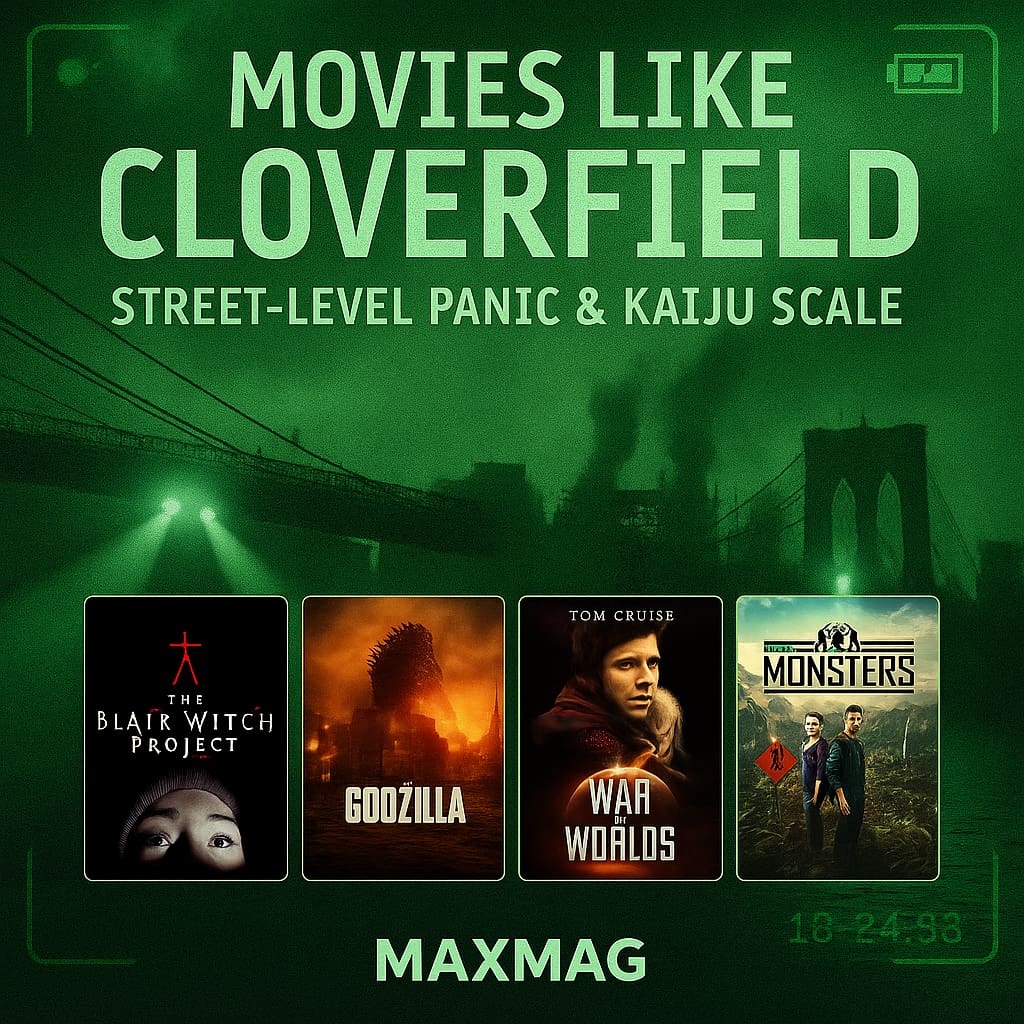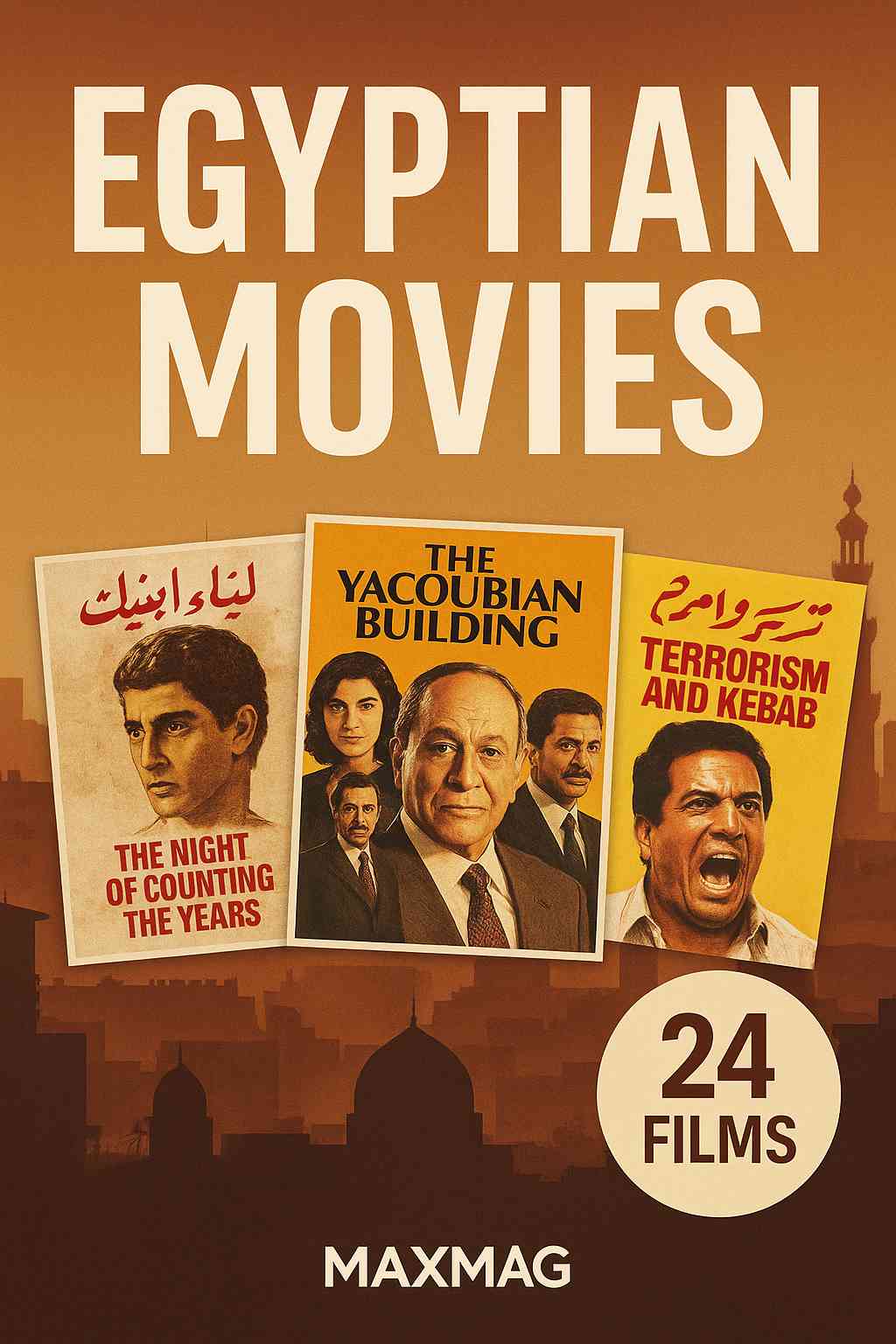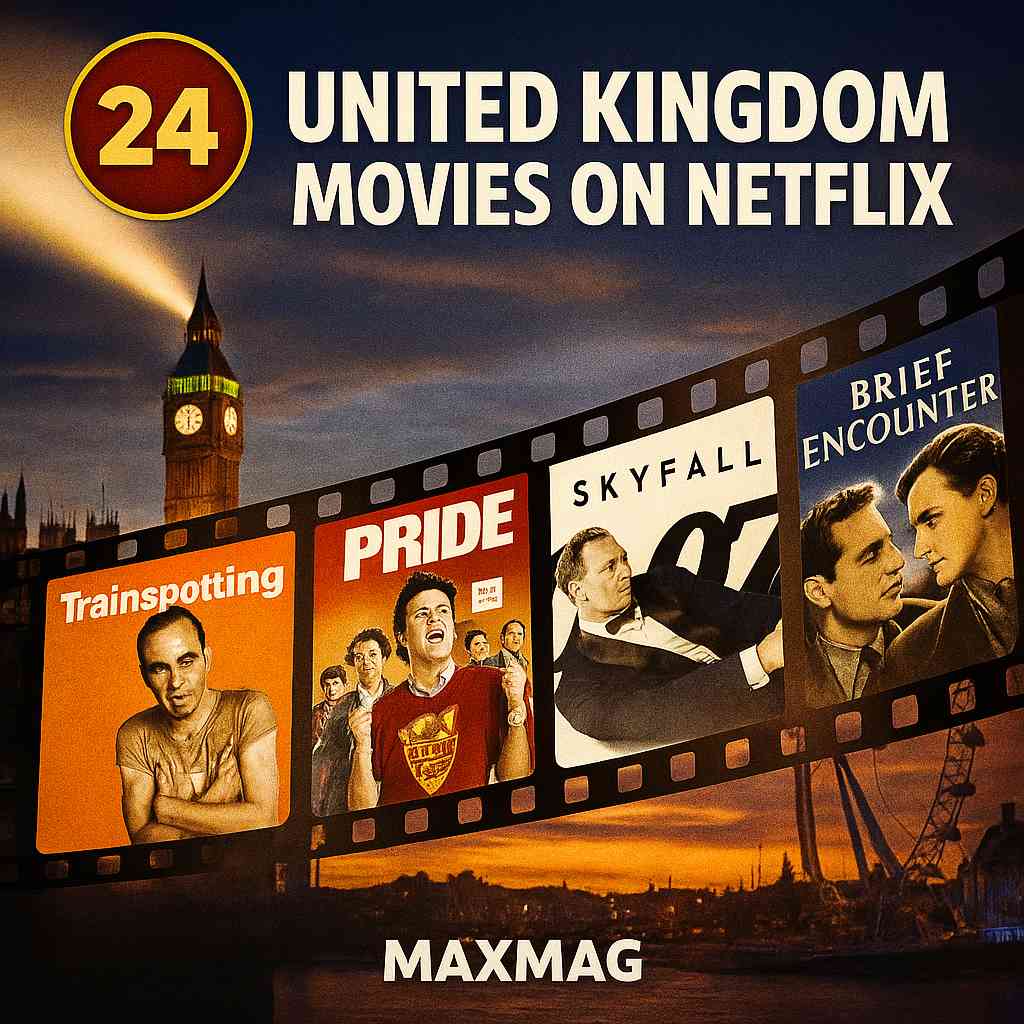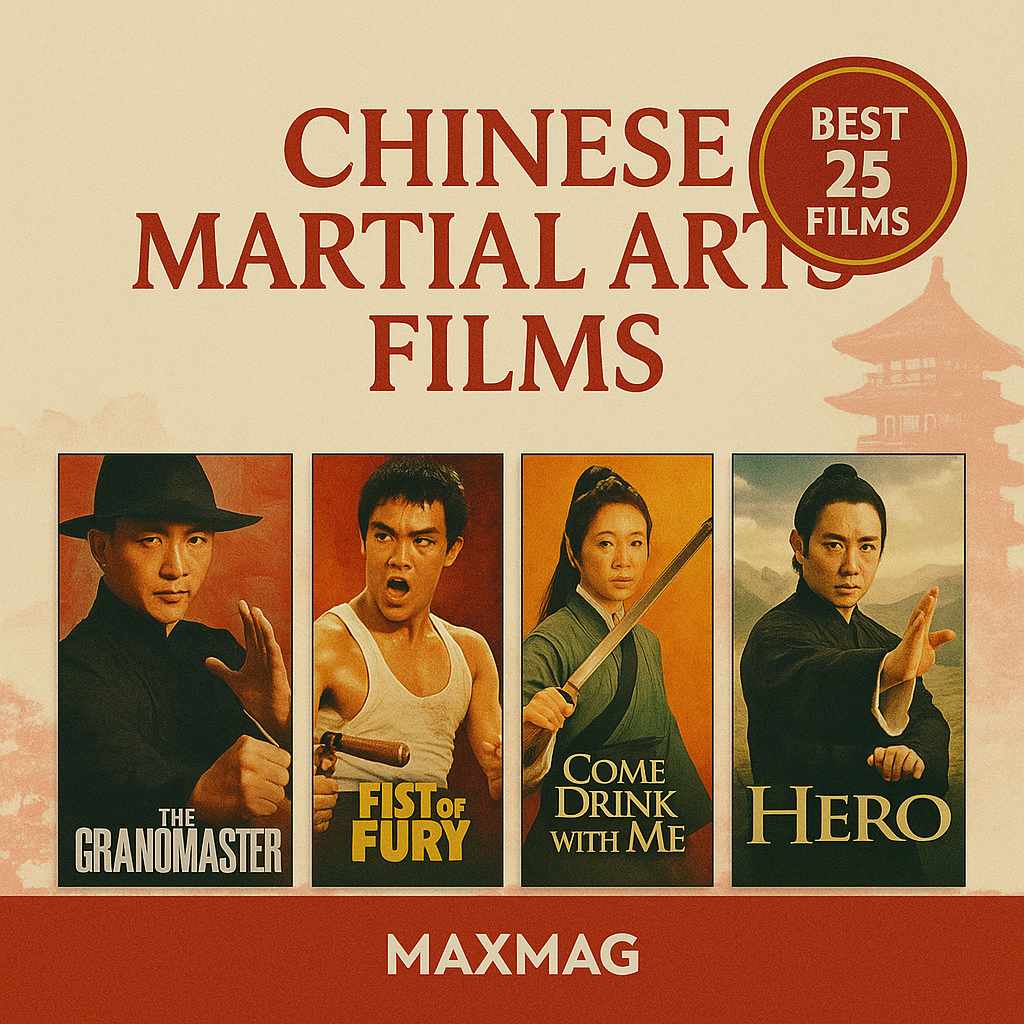
When panic hits Manhattan and a friend-group records every second of the chaos, movies like Cloverfield capture a fusion of found-footage thriller craft, creature-feature dread, urban survival logistics, first-person chaos, and escalating personal stakes. The seed film blends street-level perspective with blockbuster-scale threat, riding shaky-cam intensity and real-time disaster beats while centering fragile friendships and desperate loyalty. Its signature moments — the bridge, the bite, the blackout subway sprint — don’t just showcase a monster, they anchor a human story under pressure where every small decision can be fatal.
To mirror that specific electricity, the selections below prioritise five axes of similarity: tone that oscillates between fear and adrenaline, a narrative engine that moves minute to minute, themes of loyalty under siege and information scarcity, character dynamics built from tight ensembles, and stakes that scale from private survival to citywide catastrophe. Across these, we favoured entries that echo first-person immediacy, ground large threats in intimate viewpoints, and keep momentum ruthless, ensuring movies like Cloverfield feel cohesive rather than generic.
Jump to: Top picks | Darker options | Lighthearted picks
Best starting points if you’re hunting movies like Cloverfield tonight
1) 10 Cloverfield Lane (2016)
This spiritual companion narrows the vista to a bunker yet keeps the dread enormous. A woman wakes chained in an underground shelter where her “rescuer” insists the outside world has ended. The tone moves from wary civility to suffocating menace with tight pacing and knife-edge reversals. Dynamics mirror friend-group trust tests from the seed, reframed as a two-against-one standoff that constantly rebalances power. The sealed, makeshift setting echoes improvised survival rigs and off-screen terror. Emotionally it preserves the seed’s panic-to-agency arc, transposing it into a battle for psychological control. Fans seeking movies like Cloverfield will relish how it weaponises uncertainty. The closer lands with a breathless sprint into night and fallout.
2) The Host (2006)
Bong Joon-ho’s river-born creature surges through Seoul with shocking daylight ferocity. A dysfunctional family fights to rescue a taken daughter while dodging bureaucratic blunders and biohazard fears. The tone fuses panic, satire, and grief with propulsive chase rhythms. Ensemble friction maps cleanly to the seed’s friends-under-siege energy, only here tied by blood. Bridges, parks, and underpasses form a living city-labyrinth of ambush lines and hideouts. The payoff honours stubborn love against systemic indifference, echoing hard-won hope. Viewers chasing movies like Cloverfield will recognise the humane core beneath spectacle. The final image is a bruised prayer for ordinary people who refuse to quit.
3) [REC] (2007)
A TV reporter and her crew follow firefighters into a Barcelona apartment then the doors slam. What begins as routine coverage spirals into a quarantined nightmare mapped in shrinking hallways and breathless stairwells. The tone is relentless, clipped by alarms, screams, and flashlight beams. Group dynamics fracture into denial, duty, and doomed heroics, mirroring the seed’s loyalty stress tests. The building becomes a vertical maze where each landing is a new front. Emotionally it rides shock to fatal resolve, locking eyes with the void. Fans of movies like Cloverfield will find the immediacy surgical. The ending is a single, unforgettable descent into darkness.
4) The Blair Witch Project (1999)
The cornerstone of found-footage strips spectacle to pure disorientation. Three filmmakers enter Maryland woods chasing folklore, then the map becomes meaningless. Tension builds through bickering logistics and sonic threats, not overt sights. The triangular friendship frays like the seed’s group, each choice compounding risk. The forest is an open-air labyrinth that feels tighter than any room. Emotion lands as existential dread rather than catharsis, still brutally aligned. Seekers of movies like Cloverfield will recognise the terror of not knowing. The final frame is a thesis on where fear really lives.
5) Trollhunter (2010)
A student film team tails a grizzled poacher who hunts trolls for the government. What unfolds balances deadpan humour with awe as myths stride into floodlit reality. The tone is lighter yet pulses with night-drive tension and sudden chases. The crew-leader dynamic mirrors the seed’s improvised chain of trust and duty. Norway’s forests, plateaus, and tunnels become set-pieces for scale reveals. Emotionally it trades panic for wonder then grief, still honoring camaraderie under pressure. Fans wanting movies like Cloverfield with a wink will be pleased. The closer expands the world while keeping the camera human-height.
6) Chronicle (2012)
Three teens discover telekinesis and document the thrill as powers become a curse. The premise swings from prank levitation to police helicopters swatted from Seattle sky. The tone glides from hangout energy to tragic inevitability with crisp velocity. The triangle’s shifting loyalties mirror the seed’s moral pressure cooker. Rooftops, alleys, and hospitals reframe the city as an aerial battlefield. The emotional line tracks isolation, intoxication, and the cost of care. For audiences hunting movies like Cloverfield, it delivers first-person scale without losing intimacy. The last shot watches power implode on itself.
7) Godzilla (2014)
Edwards plays peekaboo with titans, privileging human vantage over constant monster coverage. A soldier crosses a continent to reach his family as creatures converge on cities. The tone is restrained then thunderous, punctuated by blackout tableaux and smoke. Family ties under siege echo the seed’s friendship vows under fire. Train trestles, airports, and bridges become pressure chambers where sightlines fail. The emotional cadence values small reunions amid seismic threat. Viewers craving movies like Cloverfield will recognise withheld spectacle as tension machine. The final roar is catharsis earned through patience.
![Square “Movies Like Cloverfield” thumbnail with stormy, teal NYC skyline, cracked-grain texture, and mini poster cards for “10 Cloverfield Lane,” “[REC],” “The Host,” and “Super 8.” Bold title at top, subtitle “Found-Footage Chaos & Monster Mayhem,” and “MAXMAG” centered at the bottom.](https://maxmag.org/wp-content/uploads/2025/10/movies-like-cloverfield.jpg)
8) War of the Worlds (2005)
Tripods rise from the ground and the world ends one neighbourhood at a time. A flawed father grabs his kids and runs as humanity becomes debris. The tone blends awe, terror, and breathless sprinting between safe houses. Parent–child friction mirrors loyalty tests and split-second decisions from the seed. Ferries, basements, and cul-de-sacs become choke points of panic. Emotionally it’s about protecting love when systems fail. Fans of movies like Cloverfield will feel the same air-siren dread. The basement scene is a masterclass in whispered survival.
Hunted corridors and viral dread — darker movies like Cloverfield
9) The Bay (2012)
A Chesapeake town’s Fourth of July unravels via webcams, police cams, and news feeds. The premise refracts one disaster through many lenses to diagnose civic failure. Tone is clinical then sickening as data outruns care. Character dynamics sprawl yet ring true — scattered professionals, powerless officials, terrified families. Docks, clinics, and council rooms form a bureaucratic maze. The emotions track helplessness to anger to grim clarity. If you want movies like Cloverfield with forensic texture, this is it. The final reports feel like warnings we refused to read.
10) Quarantine (2008)
An American remake of [REC] keeps the diegetic camera glued to terror. A reporter and firefighters find themselves sealed in with something furious and contagious. The tone is breathless, defined by stairwell sprints and blood-slick tiles. Team bonds splinter under conflicting orders, mirroring the seed’s pressure fractures. The building’s verticality turns every door into a trap. Emotion swings from doing the job to begging for a way out. For movies like Cloverfield seekers, it’s a grim, kinetic echo. The attic is where the story finally stops running.
11) Creep (2014)
A cash-strapped videographer answers an ad from a man with too many secrets. The premise shrinks found footage to two people in a house yet keeps stakes lethal. The tone is awkward, disarming, then skin-crawling as boundaries dissolve. The dyad mirrors the seed’s trust-versus-survival tension in miniature. Woods and living rooms become pressure cookers without exits. Emotionally it’s about how charm disarms instinct until it’s too late. Audiences craving movies like Cloverfield will recognise fear birthed from intimacy. The ending is a quiet cut that never leaves you.
Scope with wonder and camaraderie — lighter movies like Cloverfield
12) Monsters (2010)
Two strangers must cross an infected zone to reach the U.S. border. The premise drifts through checkpoints, ferries, and jungle paths under bioluminescent skies. Tone is hushed, melancholy, and exploratory with sudden peril spikes. The pair’s evolving trust echoes the seed’s group-bond endurance. Towns and temples become waypoints in a quarantined ecosystem. Emotionally it leans tender, finding love in the ruins. Viewers wanting movies like Cloverfield with gentler cadence will connect. The last scene reframes monsters as miraculous and tragic.
13) Super 8 (2011)
A group of kids filming a zombie short witness a catastrophic train derailment. The premise marries small-town grief to a caged something trying to go home. Tone is nostalgic yet tense with night raids and searchlights. The friends’ ride-or-die loyalty mirrors the seed’s ensemble panic. Schools, workshops, and culverts become investigation hubs and hideouts. Emotionally it lifts toward forgiveness and letting go. Fans exploring movies like Cloverfield with warmth will find balance here. The locket release is a perfect little goodbye.
14) Project Almanac (2015)
Teens assemble a time machine from blueprints and curiosity then push too far. The premise cascades from party tricks into catastrophic ripples across school, city, and self. Tone starts playful then turns frantic as timelines fracture. The crew’s shifting loyalties and guilt reflect the seed’s pressure on bonds. Houses, fairs, and classrooms become stages for cause and effect. Emotionally it asks what you’d undo and what cost is acceptable. If you chase movies like Cloverfield but prefer sci-fi spark, this fits. The final recording is a loop that feels like a warning.
Conclusion: where to go next for movies like Cloverfield
When you chase movies like Cloverfield you’re really chasing proximity to fear and friendship under siege. For gentle city-scale menace with humane cores start with Monsters and Super 8. If you want higher-stakes but relentlessly readable panic hit [REC] and Quarantine. For quick, punchy shocks that still feel lived-in go to Creep and The Bay. For classic creature-feature lineage fueled by real-time disaster choose Godzilla and War of the Worlds. For clue-hunt survival and bunker psychology pick 10 Cloverfield Lane. For modern city spellcraft and power gone wrong try Chronicle. To dive deeper into technique, see BFI’s guide to the mode 10 great found-footage films, and for kaiju roots read Criterion’s essay on Godzilla (1954).
FAQ: smart questions people ask when searching movies like Cloverfield
and The Host make the cut.” image-0=”” headline-1=”h3″ question-1=”Q2: Do all good picks use found-footage style?” answer-1=”A2: No. Found footage helps first-person chaos, but grounded POV and urban survival can deliver the same immediacy, as in Godzilla or War of the Worlds.” image-1=”” headline-2=”h3″ question-2=”Q3: Where are the lighter options if Cloverfield felt too intense?” answer-2=”A3: Try Trollhunter, Monsters, or Super 8 for camaraderie and wonder without losing danger.” image-2=”” headline-3=”h3″ question-3=”Q4: Which title best preserves that ensemble-on-the-run energy?” answer-3=”A4: [REC] nails it with real-time lockdown while Chronicle reframes it as friendship buckling under power.” image-3=”” headline-4=”h3″ question-4=”Q5: I want urban-survival logistics and first-person momentum. What should I start with?” answer-4=”A5: Begin with 10 Cloverfield Lane for claustrophobic realism, then jump to Quarantine for continuous, handheld urgency.” image-4=”” count=”5″ html=”true”]
(2007)
CreativeWork: The Blair Witch Project (1999)
CreativeWork: Trollhunter (2010)
CreativeWork: Chronicle (2012)
CreativeWork: Godzilla (2014)
CreativeWork: War of the Worlds (2005)
CreativeWork: The Bay (2012)
CreativeWork: Quarantine (2008)
CreativeWork: Creep (2014)
CreativeWork: Monsters (2010)
CreativeWork: Super 8 (2011)
CreativeWork: Project Almanac (2015)
Person: Matt Reeves
Person: J.J. Abrams
Person: Bong Joon-ho
Person: Gareth Edwards
Person: Jaume Balagueró
Person: Paco Plaza
Person: Steven Spielberg
]




